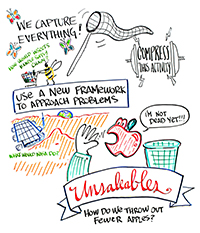Food retailers name three ways to cut "unsaleable" goods out of supply chain
| Notes from a brainstorming session on unsaleables at the TPA Supply Chain show. |
Food industry manufacturers and retailers can generate large cost savings by collaborating to reduce the volume of "unsaleable" items, such as damaged or expired goods in their supply chains, according to experts attending a consumer packaged goods (CPG) conference this week in San Diego.
The effort can generate quick returns by addressing the $15 billion of goods the industry tosses every year, according to Daniel Triot, senior director for the Trading Partner Alliance (TPA). But the effort will take close collaboration between partners such as manufacturers and retailers, Triot said. He spoke Tuesday at the TPA Supply Chain show, a conference hosted by the TPA joint committee of the trade associations Food Marketing Institute (FMI) and Grocery Manufacturers Association (GMA).
The three most efficient strategies for reaching that goal are: enhanced shelf life management, effective management of discontinued items, and sharing of universal product code (UPC)-level data, according to a joint study by the TPA and its research partner, pallet vendor and supply chain solutions provider CHEP.
The two groups recently conducted an industry survey that ranked the effectiveness of 48 strategies for reducing unsaleables through more effective supply chain management. The research "uncovered clear patterns for reducing unsaleable goods," Ben Eugrin, CHEP's director of supply chain solutions, said in a statement today. "We now know how retailers, manufacturers, and suppliers, working together, can generate significant cost savings that positively impact their bottom line."
The partners plan to launch an educational platform this fall, sharing detailed information and tools to help trading partners review their supply chains and implement effective unsaleables-reduction strategies. The platform will crowd-source evolving unsaleables-reduction strategies, the partners said. Strategies already in development reducing the high disposal costs of hazardous materials such as batteries and hairspray cans and generating a return on food waste by recycling expired products for livestock feed, Eugrin said.
"The key principle is that we need to improve collaboration between trading partners," Eugrin said in an interview. "That can be helpful, because not all companies have someone in charge of unsaleables. There can be a difference in perspective between manufacturers and retailers, and retailers and CPG companies might have different interests, so how can we connect them?"
Related Articles

Copyright ©2024. All Rights ReservedDesign, CMS, Hosting & Web Development :: ePublishing


